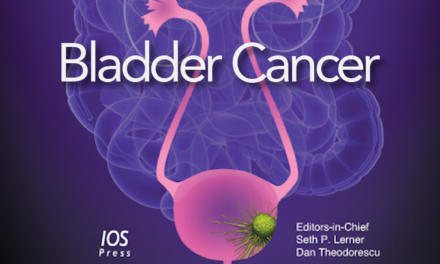Dr. Michael S. Cookson presented “Enhanced Technique Endoscopic Visualization in NMIBC” at the International Bladder Cancer Update meeting on Tuesday, January 24, 2017.
Keywords: non-muscle invasive bladder cancer, Cysview, optical coherence, confocal laser, endomicroscopy
How to cite: Cookson, Michael S. “Enhanced Technique Endoscopic Visualization in NMIBC” January 24, 2017. Accessed Apr 2024. https://dev.grandroundsinurology.com/enhanced-technique-endoscopic-visualization-nmibc
Transcript
Enhanced Technique Endoscopic Visualization in NMIBC
I’m going to talk a little bit on enhanced techniques for detection non-muscle invasive bladder cancer. So, what we’ll go over in the time that we have for this is some of the limitations of white light cystoscopy, what are the new commercially available technologies that we’re using, how has this impacted on our ability to detect these tumors, what about its impact on recurrence and reducing recurrences, and what are these recommendations based on guidelines for the future?
We know the goal of a TURBT is to resect all visible tumor, and that’s using conventional white light, but if we can’t see it we can’t resect it, and so that’s one of the limitations that we’ve found, and if we don’t do a good job and don’t completely resect tumors bad things can happen, recurrence, progression, etcetera. And I’ll show you some of that.
This is just two highlighted series that looked at 150 patients and 47 patients who in a relatively short period of time underwent a repeat TURBT within two to six weeks after initial resection, and the commonality between both these series is about 70% of the time there was still residual tumor. In the series by Harry Herr’s group about 20% of the time that meant an increased stage of cancer, and treatments were altered in 30% of the time. So, we think we get it all, but we probably don’t no matter who we are.
There are several emerging technologies such as optical coherence and confocal laser, endomicroscopy, which are in trials. Some of our panel members have some experience with that. The two commercially available are the blue light or Hexvix/Cysview, and narrow band, and we’re going to focus on those really. So, narrow band takes advantage of the fact that you can illuminate with different bandwidths, certain things that you want to see in tissue, and using a blue and a green relatively narrow band you can get hemoglobin and thus vascular structures more clearly highlighted. And I like this slide, even though it’s a ski meeting, because these little people are the little brown tumors kind of floating on a shallow green sea, and that’s really the best way to think about how the narrow band works when we see it in tumors. It’s not just used in urology, it’s being used in other cancers such as oral cancers, lung cancers. And one of the things that you can do with it is it has both rigid and flexible capabilities, so you can use it in the upper tract as well as in the bladder, and you can use it in the office. So, this is back to that slide that shows the little brown patches floating on the green sea, and it can enhance the visualization. In the United States Olympus is the group that has this available through their instrumentation.
This is a study looking at the use of narrow band in a randomized study in 148 patients narrow band as compared to a traditional white light. And what they found was they had enhanced detection, so it was significant, and this translated into a reduction in recurrences by about 20% at the one-year mark. That study and others have shown ability to show improved detection. This was a study from Memorial Sloan Kettering looking at following patients for about three years with white light versus following them with narrow band, and again better detection resulted in a reduced recurrence rate, which is a benefit to savings for the healthcare system as well as for the patient.
This is a small series of upper tract, but what they noticed was that about 25% or so of patients had enhanced detection using this technology, and this can range from additional tumors that are then subsequently ablated, perhaps better ablation because you see the edges more, and you’ll miss some tumors all together, maybe up to 10% without it. So, it seems to have value in the upper tract.
The other one is blue-light or Cysview technology, and some of you may have familiarity with this as well. This takes advantage of some properties of the Hexvix, which was originally approved in Europe in 2005 and got FDA approval in 2010. It’s manufactured by Photocure, and what it does is you instill this in the bladder, for those of you who haven’t used it. There is a selective uptake in the vascular structures of tumor cells, which then can be accentuated when you use the blue light to show these tumors up to ten times more concentration in the tumors over normal tissue. Like the narrow band it requires some special instrumentation. So, in the United States the Cysview is linked to the Karl Storz tower with a special light, a special camera, a special scope, and a special fluid light cable. So, some of this additional, this is just the Cysview that you need to instill usually an hour before you do your procedure.
This is a summary slide of several of the randomized trials that have looked at the blue-light technology, and all of them have shown statistical improvement in not only papillary tumors but also especially in detection of carcinoma in situ in these flat tumors.
This was the pivotal U.S. study that several of us in the room participated in, had about 800 patients. It showed enhanced detection of papillary lesions. Now, this is in the OR. Right? Because you don’t have the ability to in this particular study do it in the office with a flexible cystoscope, and there was an addition–increased by about 30% the detection of CIS. So, this then resulted in a reduction in tumor recurrences as was seen in the original study by relatively about 16%. Dr. Grossman and some followed patients even longer, and did a several-year follow up and found in long-term follow up that this was a durable reduction in recurrence, and that’s independent of any intravesical therapies that were rendered.
Meta-analyses have also born out the benefit of this blue-light technology in both papillary and CIS, and then translating into a reduction in recurrence. This is their forest plot for benefit demonstrated in the papillary tumors, TA and T1. This is their meta-analysis results for CIS and in both highly positive and statistically significant.
These are just some slides to kind of demonstrate in some of the best case scenarios some of the ways that you can see enhancement where you might not see it on a conventional diagnostic white light. There’s economic factors, and as I mentioned for both of these new technologies there’s a cost associated with it. That is a barrier to adoption in the United States for several especially smaller centers. But in terms of the economics of it after the upfront cost or the lease arrangement, whichever you do, there is benefit to the healthcare system in terms of a cost savings due to the reduction in recurrences, and in some European studies for example they’ve estimated maybe a 200,000-dollar saving to the patient over the course of their lifetime during this monitoring. So, we know that bladder cancer in the United States is the most expensive tumor that we treat pound for pound in the Medicare system because there are so many recurrences and so many procedures done. So, it could be something that could actually reduce the cost.
Areas of research; so, we and others in this room are participating in a flexible blue-light trial. It has several goals, but one of them is to use the technology in surveillance in the office. The second one is to look at repeated uses of the technology. The third one is to look at response after intravesical therapy such as BCG. So, that’s ongoing.
What are the recommendations from the governing bodies? So, the European endorse the use of blue light for all patients with non-muscle invasive bladder cancer for the reasons that are listed there and the reasons that I’ve reviewed earlier. This is European Urology updated recommendations, and in addition some other countries such as Germany, UK, and Nordic, some of those really are just consensus panel statements rather than true rigor of a guidelines statement like Dr. Chang showed. But again, you can see that they’re adapting this technology into their recommendations, not only for newly diagnosed patients but for recurrent patients, including those that are failing after intravesical therapy. These were highlighted by Dr. Chang, but now incorporated into the AUA guidelines are the potential benefits of the blue light as well as the narrow band based on the levels of evidence as demonstrated there.
In conclusion, enhanced visibility with this new technology allows us to detect more tumors, especially carcinoma in reduction in the recurrence of these patients. This reduces the burden of TUR on these patients. It could ultimately result in a savings in the healthcare system, and it is recommended by guidelines both nationally and internationally.






